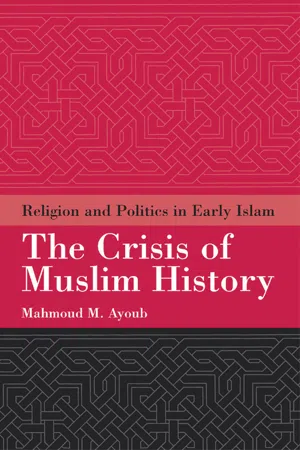History
Rightly Guided Caliphs Period of Rule
The Rightly Guided Caliphs were the first four leaders of the Islamic community after the death of the Prophet Muhammad. Their rule is known for its adherence to the principles of justice, consultation, and humility. This period is highly regarded in Islamic history for its emphasis on governance based on the teachings of Islam and the traditions of the Prophet.
Written by Perlego with AI-assistance
Related key terms
5 Key excerpts on "Rightly Guided Caliphs Period of Rule"
- Gerhard Bowering, Patricia Crone, Wadad Kadi, Devin Stewart, Muhammad Zaman, Mahan Mirza(Authors)
- 2012(Publication Date)
- Princeton University Press(Publisher)
Throughout the centuries, however, various other rulers have made claims to the caliphate or adopted the caliphal titulature—that is, one or more titles usually associated with caliphs. The first four successors of the Prophet Muhammad are usually called the Rightly Guided Caliphs (al-khulafā’ al-rāshidūn). But those Muslims who do not accept the legitimacy of some of these rulers refrain from applying this expression to them. Despite the ubiquitous use of the terms “caliphate” and “caliph” in modern scholarship, they were not the principal or exclusive terms used in official documents or in the writings of Muslim authors, nor were they adopted immediately following Muhammad’s death. Many Muslim writers eschewed these two terms in favor of alternatives, especially imam and imāma, or (religious) leader and leadership. The two terms, “caliph” and “caliphate,” were almost always employed in conjunction with other terms and expressions. They also hardly appear in official or unofficial documentary sources (papyri, coins, rock inscriptions, textiles, weights, and seals), and non-Muslim sources do not use them when referring to Muslim sovereigns or to Islamic political institutions, especially for the first Islamic centuries. The institution of the caliphate developed gradually with time and crystallized only at the beginning of the Abbasid period in the second half of the eighth century. Also, despite their claims to universal rule over all Muslims, few Muslim sovereigns actually did so; many provinces and regions controlled by Muslims did not acknowledge the suzerainty of any caliph. Furthermore, the caliphs possessed actual power for a relatively short period, as they became mostly puppets in the hands of military commanders and high-ranking officials. The history of the development of the institution of the caliphate can be divided as follows: 632–945. This timespan covers three periods- eBook - ePub
The Meaning of Mecca
The Politi of Pilgrimage in Early Islam
- M E McMillan(Author)
- 2012(Publication Date)
- Saqi Books(Publisher)
TWO Following in the Prophet’s Footsteps: The Era of the Rightly Guided Caliphs Table 1 shows who led the ḥajj during the caliphates of the four Rightly Guided caliphs, the Rāshidūn : Abū Bakr, ‘Umar b. al-Khaṭṭāb, ‘Uthmān b. ‘Affān and ‘Alī b. Abī Ṭālib. Table 1 Year Ḥajj leader Relationship to caliph Governor of a Holy City? Abū Bakr 11/633 ‘Abd al-Raḥmān b. x x ‘Awf 1 or ‘Attāb b. Asīd 2 or x Mecca ‘Umar 3 x x 12/634 Abū Bakr 4 or CALIPH - ‘Umar 5 or x x ‘Abd al-Raḥmān 6 x x ‘Umar 13/635 ‘Abd al-Raḥmān x x b. ‘Awf 7 or ‘Umar 8 CALIPH - 14/636 ‘Umar 9 CALIPH - 15/637 ‘Umar 10 CALIPH - 16/637-638 ‘Umar 11 CALIPH - 17/638 ‘Umar 12 CALIPH - 18/639 ‘Umar 13 CALIPH - 19/640 ‘Umar 14 CALIPH - 20/641 ‘Umar 15 CALIPH - 21/642 ‘Umar 16 CALIPH - 22/643 ‘Umar 17 CALIPH - 23/644 ‘Umar 18 CALIPH - ‘Uthmān 24/645 ‘Abd al-Raḥmān x x b. ‘Awf 19 or ‘Uthmān 20 CALIPH - 25/646 ‘Uthmān 21 CALIPH - 26/647 ‘Uthmān 22 CALIPH - 27/648 ‘Uthmān 23 CALIPH - 28/649 ‘Uthmān 24 CALIPH - 29/650 ‘Uthmān 25 CALIPH - 30/651 ‘Uthmān 26 CALIPH - 31/652 ‘Uthmān 27 CALIPH - 32/653 ‘Uthmān 28 CALIPH - 33/654 ‘Uthmān 29 CALIPH - 34/655 ‘Uthmān 30 CALIPH - 35/656 ‘Abd Allāh x x b. al-‘Abbās 31 ‘Alī 36/657 ‘Abd Allāh cousin x b. al-‘Abbās 32 or ‘Ubayd Allāh cousin x b. al-‘Abbās 33 37/658 ‘Abd Allāh 34 or cousin x ‘Ubayd Allāh 35 or cousin x Qutham cousin Mecca b. al-‘Abbās 36 38/659 Qutham 37 or cousin Mecca ‘Ubayd Allāh 38 cousin x 39/660 Shaybah b. x Ḥājib (Keeper) of the Ka‘bah ‘Uthmān b. Abī Ṭalḥah 39 ABŪ BAKR: LEADERSHIP OF THE ḤAJJ AND THE NATURE OF AUTHORITY IN ISLAM In Table 1, Ibn Khayyāṭ, al-Ya‘qūbī, al-Ṭabarī and al-Mas‘ūdī cite Abū Bakr as leader of the ḥajj in 12/634. But Ibn Khayyāṭ and al-Ṭabarī also cite the early convert ‘Abd al-Raḥmān b. ‘Awf and the future caliph ‘Umar as alternative leaders for that year’s ḥajj. Al-Ṭabarī, for one, drew his information for leadership of the ḥajj from different sources – Abū Ma‘shar and al-Wāqidī – who did not always agree - eBook - ePub
The Crisis of Muslim History
Religion and Politics in Early Islam
- Mahmoud Ayoub(Author)
- 2014(Publication Date)
- Oneworld Publications(Publisher)
5‘Uthmān: Khalīfat Allāh
‘Uthmān’s caliphate constituted a total break with tradition and ushered in a new era of Muslim history. It was a break with the pious and somewhat austere framework within which the two venerable elders, Abū Bakr and ‘Umar, served the people in that it transformed the caliphate from an essentially tribal-religious authority into an autocratic institution. It ushered in a new era in that it brought to power a new dynasty that would change the structure of Muslim society and alter the course of its history.Abū Bakr, it should be remembered, saw himself as an inadequate but faithful representative (khalīfah ) of the Messenger of God. Although ‘Umar chose the epithet “ amīr al-mu’minīn ” (“Commander of the Faithful”), he nonetheless saw himself as “the successor of the successor of the Messenger of God.” ‘Uthmān, in contrast, preferred the title khalīfat Allāh (God’s representative), and thus did not feel bound by the precedent of the two elders.1 ‘Uthmān saw his rule as a God-given authority, resembling that of divine-right kingship rather than successorship (khilīfah ) to the Prophet of God.‘Uthmān’s Caliphate: Umayyad Power and the Beginning of Shī‘ī Opposition
The twelve-year rule of ‘Uthmān, the shaykh of the sons of Umayyah and twice son-in-law of the Prophet, was a period of intrigue and tragedy, of sedition and disenchantment. It led some among the Muslims to seek alternatives to the caliphal model and others to withdraw from social and political affairs altogether. Broadly speaking, the first group crystallized in Shi‘ism, the second in Sufism. ‘Uthmān’s rule set the stage for a degree of schism and civil strife that shook the Muslim ummah to its foundations.It was observed earlier that neither Abū Bakr nor ‘Umar saw their rank on the Prophet’s seat of authority (the minbar ) as equal with their rank and status. Thus Abū Bakr sat a step lower than the Prophet, and ‘Umar sat a step lower than Abū Bakr. ‘Uthmān, we are told, sat on the topmost step, where the prophet used to sit. When people questioned him about this highly symbolic act, he simply replied that Abū Bakr and ‘Umar had prepared the gesture for him. Some of the people present saw this as an ominous innovation, and one man observed, “Today evil was born.” Ya‘qūbī, who reported this event, added that as a result, some men were inclined towards ‘Alī and spoke critically of ‘Uthmān.2 Such men came to form an important element of the nucleus of ‘Alī’s followers (shī‘ah ) and to champion the cause of the Prophet’s family (ahl al-bayt - eBook - ePub
Longing for the Lost Caliphate
A Transregional History
- Mona Hassan(Author)
- 2017(Publication Date)
- Princeton University Press(Publisher)
37 MUSTAFA SABRİ (1869–1954)In November 1922, the Ottoman scholar who had served at the pinnacle of the empire’s religious hierarchy, the former şeyhülislam Mustafa Sabri, fled Istanbul for his life,38 but facing the harsh consequences—even enduring exile—because of his outspoken political and intellectual views was not a new experience for this leading traditionalist scholar. Mustafa Sabri was born in the town of Tokat in the central Black Sea region of Anatolia on June 21, 1869, and completed memorizing the Qur’an before he was ten. He began his early education in Tokat before persuading his mother to intercede for his father’s permission to continue his religious studies in Kayseri. From there, he went on to pursue more advanced studies in Istanbul, where he met and studied with Gümülcineli Ahmet Asım (1836–1911), the Şeyhülislam Office’s Commissioner of Seminary Education (Ders Vekili). Mustafa Sabri’s powerful intellect and depth of knowledge so impressed the distinguished scholar and administrator that he awarded Mustafa Sabri a diploma (icazet) within two years, encouraged him to take the advanced Rüus examinations as early as 1890, and married his stellar pupil to his own daughter in 1892. Mustafa Sabri’s professional career included appointments teaching in seminaries, discoursing in the prestigious imperial lecture series, and working as private librarian for the Ottoman sultan Abdülhamid II. Politically, Mustafa Sabri bristled at the restrictions on free speech in the Hamidian era, and after the 1908 Young Turk Revolution, Mustafa Sabri actively strove to realize a constitutional democracy. He was elected as a Unionist candidate to the restored Ottoman Parliament in 1908 but became disillusioned with the CUP the following year when they blocked his popular legislative efforts to expand the codification and application of Islamic law in the Mecelle - eBook - ePub
Caliphate Redefined
The Mystical Turn in Ottoman Political Thought
- Hüseyin Yılmaz(Author)
- 2018(Publication Date)
- Princeton University Press(Publisher)
Nor was there any systematic political theory to define the historical caliphate in this period. In fact, the principal term that defined the historical caliphate as the successor of the Prophet (khalīfat Rasūl Allāh) was rarely used. Yet the caliphate remained one of the most defining designations in use during this period. The predominant concept of the caliphate, however, was the one defined by mystics, not by jurists who considered it as God’s vicegerent (khalīfat Allāh) that could be attained not through a contract with or subjugation of the Muslim community, but through learning, piety, morality, and spiritual perfection. God’s Government Qualifying the sultan with such designations as khalīfa and ẓill Allāh tied rulership to God’s government over His creation, which was frequently alluded to as the perfect model and an authoritative source of legitimacy for rulership. Political authors, inspired by theological doctrines regarding God’s relation to the creation, inferred manifestations of God’s government and compared them to temporal government in order to establish principles of ideal political authority. The most conspicuous outcome of this political reasoning was to conclude that the unity of God’s government provided an absolute model for earthly rulership as a single, undivided, and comprehensive authority
Learn about this page
Index pages curate the most relevant extracts from our library of academic textbooks. They’ve been created using an in-house natural language model (NLM), each adding context and meaning to key research topics.




